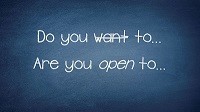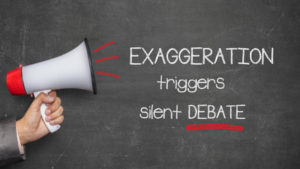How to Give More by Offering Less
 Are people crankier these days? Not sure if it’s the pressures of everlasting covid restrictions, the rush to get business done before year-end, or the onset of winter weather and reduced sunlight, but I’m noticing people becoming more short-tempered these days. (Disclaimer: This behavior absolutely does not apply to my wonderful wife, Lydia, who is always cheerful, constantly sees the sunny side of life, and often reads these tips)
Are people crankier these days? Not sure if it’s the pressures of everlasting covid restrictions, the rush to get business done before year-end, or the onset of winter weather and reduced sunlight, but I’m noticing people becoming more short-tempered these days. (Disclaimer: This behavior absolutely does not apply to my wonderful wife, Lydia, who is always cheerful, constantly sees the sunny side of life, and often reads these tips)
In response to this snippiness, despite my temptation to lash back, I’m finding myself forced to bite my tongue and - in the case of written communications - soften my touch on the keyboard. It occurs to me that there are indeed three areas of work and life where it pays to keep our opinions to ourselves...
Politics at work. A sign on a cash register at a retail store states: “Please don’t share your opinions about vaccines. I’m tired of hearing about it.” While I don’t advocate posting that kind of a message, I can understand the sentiments. Expressing political ideologies to customers and colleagues will likely do nothing to change the issue. It is, however, guaranteed to annoy and turn off a certain percentage of people who disagree. Sharing political opinions at work has no upside and significant downside.
Written communications. Assume that anything that you text or email about a person will be read by that person. We all occasionally encounter difficult colleagues, co-workers, and customers. And while venting our frustrations may happen, it shouldn’t be done in writing – ever.
Petty annoyances. Crumbs left on the countertop, room temperature too hot or cold, two squares left on a toilet paper roll, the list of annoyances can be endless. And no one – particularly those you live with – want to hear about them. The reality is these are the people who are most invested in you, and who you’d likely miss the most if something were to happen to them. Feeling annoyed at little things is human. Sparing others from hearing about them is humane.
Sometimes the kindest way to get along and feel more harmony with others is to offer less. Less of our opinions, that is. Remember that often holding our peace, means holding on to peace.
The Rudest thing you can Do in a Virtual Meeting
 I should qualify that title. As you can imagine, there are plenty of inappropriate behaviors that people could display on Zoom or Teams. Some are obvious: taking phone calls, talking to coworkers in the background, forgetting to wear pants (yikes)! In terms of virtual rudeness, I’m referring to the most common etiquette sin many people commit in the first five seconds, without being aware of it.
I should qualify that title. As you can imagine, there are plenty of inappropriate behaviors that people could display on Zoom or Teams. Some are obvious: taking phone calls, talking to coworkers in the background, forgetting to wear pants (yikes)! In terms of virtual rudeness, I’m referring to the most common etiquette sin many people commit in the first five seconds, without being aware of it.
I’m referring to logging in ‘late’, and by late I mean arriving at exactly the appointed meeting time. I learned the lesson decades ago as a university student at a business class where they’d invited a vice president of Trimac Transportation as a guest speaker to share real-world advice on unwritten rules of advancing your career and enhancing your workplace reputation.
One of his tips was the importance of arriving for meetings on time. He explained that if you arrive 10 minutes early, the client may feel rushed. And it looks like you didn’t have much else to do. If you arrive just one or two minutes early or at exactly the appointed time, it seems like you barely made it, and they might have already been wondering if you’d show up. Let’s not even talk about arriving late! “The ideal time to arrive for a meeting,” he advised, “is five minutes early.”
I believe that five minute rule still applies - particularly for virtual meetings. I was reminded of it recently when I was asked to mentor a business student as a favour to a colleague. The student and I scheduled a Zoom meeting, and he arrived at exactly the appointed time. I was slightly annoyed. He requested the meeting, yet he isn’t there to greet me as I arrive? Imagine if you were invited to someone’s home and you show up a few minutes early (which you shouldn’t, but that’s a different tip), only to find the host doing chores and surprised to see you. Doesn’t exactly make you feel special or welcome, does it?
More importantly these days, we all may be suffering from a lack of in-person connections with customers, colleagues, and coworkers. Arriving at the meeting start time means losing the opportunity for pre-meeting chit chat. In person, you arrive for a meeting five minutes ahead of time, get settled in and quietly ask your colleague next to you, “How is your mom doing after her surgery?” We lose that kind of intimacy when there are five people on a Teams call covering agenda point #3. Plus, with technology, there’s a chance we may have some technical glitches that take some time to get sorted.
What do you think – is just in time really on time? I’d love to hear your thoughts.
The Future of Customer Service
 3 buying trends to capitalize on in 2022
3 buying trends to capitalize on in 2022
Have you ever seen this much marketplace disruption? The year 2022 marks my 30th anniversary of client companies bringing me in to work with their sales and service teams to grow their business. Over my three decades of speaking, training, and writing on the topic I’ve never seen a shift in customer buying behaviors as dramatic as those we’ve recently experienced during the pandemic. Consider how you and your organization can capitalize on the following big three trends.
Buying Trend #1 - Convenience is King
The pandemic exploded online buying particularly at Amazon. Interestingly, Amazon doesn’t sell products. It sells convenience. Compare buying from Amazon to the typical retail shopping experience. With Amazon you don’t have to go anywhere, you push one ‘buy now’ button and receive it often the next day.
Similarly, when it comes to service, Skip the Dishes doesn’t sell meals, it sells convenience. You can order any menu item from any member restaurant, and it’s done. A map app shows you exactly where the delivery person is, and exactly when it will arrive.
Your moves: If you sell products online to repeat customers, do they have to input all their payment and delivery information every time? Or instead, can you use the Amazon approach and collect and store customer details once, to make it easier for them to order repeatedly from you?
If you sell services, then could you use similar software as Skip the Dishes and Uber so that customers can track on their phones exactly when the delivery will arrive, or how long their wait time will be?
Don’t compare your company to your industry competitors. Compare yourself to Amazon and Uber. Make your customers’ buying experience more hassle-free and convenient. You’ll differentiate yourself in your marketplace while making price less relevant.
Buying Trend #2 - Frustration with Shortages
I’m too young to have lived during the World War years, when many countries imposed rationing. During the pandemic, however, we all experienced commodity shortages that led to delivery delays and price swings. Those shortages of materials will eventually right themselves as the pandemic subsides. Unfortunately, the more persistent shortage that will remain for the foreseeable future – staffing.
The pandemic didn’t create a staffing shortage, it just made it more pronounced. The labour shortage that began long before the pandemic is a function of demographics and lower birth rates in developed nations. That’s not going to change any time soon.
In what’s often referred to as the war for talent, it’s critical for organizations to successfully hire, motivate, and retain staff. Many managers believe the only way to accomplish that is to pay higher wages. In reality, we’ve discovered working with clients across dozens of industries, engaging and retaining employees doesn’t necessarily mean paying more.
In researching my book “Becoming a Service Icon in 90 Minutes a Month”, I was impressed by the work Dr. Kenneth Kovach, a renowned researcher of employee motivation. Ken related to me that the #1 motivator of employees is not money – it’s actually interesting work.
Your moves: A simple way to make work more interesting is to train employees on communication skills. Specifically - how they can effectively communicate with customers when handling unexpected delivery delays or price spikes. When we work with teams, for example, we equip them with phrases to manage customer expectations, take ownership, and earn respect. That creates a better experience for customers and a more rewarding, stress-free environment for employees. It’s a win for everyone; even when there are shortages of commodities and employees. To enhance staff engagement and retention, could your team use a tune-up in customer communications?
Buying Trend #3 - Less in-person communications
Did the pandemic ever lead you to feeling Zoomed-out or Teamed-out? If so, you’re not alone. For better or worse, virtual meetings aren’t going away. Most managers agree that sitting behind a camera doesn’t come close to the benefits of a site visit or a hallway conversation at a convention. If however, the in-person meeting merely involves people sitting at desks or around a boardroom table, then the virtual meeting comes reasonably close. Often at a fraction of the cost than if travel was required.
Your moves: If you haven’t yet, it’s time to embrace virtual meetings. According to the Harvard Business Review, shifting your impersonal email or text client communication to more personal face-to-face or virtual meetings, increases your chances of closing the sale by 34 times. That’s quite a difference!
A virtual format also makes team training easier and more cost-effective. For many businesses whose employees were geographically dispersed, it was often cost-prohibitive to physically assemble them for training. Now with the virtual option available, you eliminate not only the travel expense, but also travel time. Plus Zoom offers wonderful options for smaller group discussions, polls, and engagement. Suddenly, virtual training becomes more fun, affordable, and impactful.
Which will you embrace?
So, which of these three trends do you see either being a threat or an opportunity for your business? The pandemic certainly hit a lot of people in a negative way, and not just for the devastating health impacts. On the other hand, the topsy turvy world of the last two years has inadvertently uncovered opportunities to differentiate your service and enhance employee engagement. I’d love to hear from you with your plans for adapting in the year ahead.
By Jeff Mowatt (original content – not AI generated).
Could your team use a tune-up with their customer communications? Let’s talk! Call us at 1-800-JMowatt (566-9288), or email [email protected]. We’ll schedule a brief zoom call for you and Jeff to chat about your needs. Then if it looks like a possible fit, Jeff will put something in writing for you to consider. We look forward to hearing from you!
Write this when customers request price quotes
 Imagine a customer emailing or texting you for a price quote. The temptation may be to simply reply with a price or range of prices and hope for the best. But if you are not the lowest price provider in your industry, then for obvious reasons that’s rarely an effective strategy.
Imagine a customer emailing or texting you for a price quote. The temptation may be to simply reply with a price or range of prices and hope for the best. But if you are not the lowest price provider in your industry, then for obvious reasons that’s rarely an effective strategy.
Your best chance of actually making the sale is to start by having a face to face in-person or virtual conversation. That way you can drill down and identify their needs other than price. The challenge is you aren’t likely to get that meeting with a busy person by simply replying with, “Do you want to have a meeting and talk more about your needs?” Instead, consider responding with…
We have a range of prices depending on several factors. And I’ll be happy to look into those options for you. But first I need to know if you’re open to us sitting down and having a conversation to give me a better idea of your project/ plans and how this might fit in. That way I can come up with pricing options that are relevant. Are you available later this afternoon or tomorrow morning?
If they aren’t open to scheduling a meeting, it’s a good indication they aren’t serious about potentially buying from you. In that case, I suggest you don’t send prices. Focus on more qualified buyers.
The key words in the above phrasing – are you open to… Notice we aren’t asking, “Do you want to… or would you like to…” Busy professionals don’t want or like to have unnecessary meetings. Meanwhile, most people like to think of themselves as being open-minded. Asking a customer if they are open to… is an easy way of not only asking for an appointment, but also determining if they are open to considering a different approach to solving their problem. Big difference for changing a few words.
Dealing with Angry Covid Customers
5 tips to help prevent customer conflicts from going viral on social media
 I noticed a surge in views and comments recently on a YouTube video I posted several years ago on the topic, “Dealing with Hostile and Abusive Customers.” Turns out the recent spike has to do with frontline staff needing to ask customers for proof of vaccination, and the sometimes angry responses. Since the video was posted before covid and it doesn’t talk specifically about vaccine passports, I wanted to pass along a few tips here on how to prevent nonvaccinated customers from becoming irate and unruly. Consider them as tips to prevent you and your employees from ending up on an unflattering viral video on YouTube.
I noticed a surge in views and comments recently on a YouTube video I posted several years ago on the topic, “Dealing with Hostile and Abusive Customers.” Turns out the recent spike has to do with frontline staff needing to ask customers for proof of vaccination, and the sometimes angry responses. Since the video was posted before covid and it doesn’t talk specifically about vaccine passports, I wanted to pass along a few tips here on how to prevent nonvaccinated customers from becoming irate and unruly. Consider them as tips to prevent you and your employees from ending up on an unflattering viral video on YouTube.
Tip #1 Word your proof of vaccine request positively
In my customer service training seminars, we talk about the importance of wording your messages positively – especially when giving someone ‘bad news’. Notice, for example, the difference in tone with, “We won’t be able to deliver until Friday,” vs “We’ll have it for you as soon as Friday.”
Using positive language with vaccine passports, rather than saying, “We can’t serve you without proof of vaccination,” instead say, “Welcome! We’ll be happy to take care of you as soon as we see your proof of vaccination.”
Tip #2 Listen before responding
If the customer doesn’t have proof of vaccine or claims they don’t agree with the policy, then it’s time to explain limits and show understanding. “In order to protect the health of our customers and staff, we do require proof of vaccine. I understand if you don’t happen to have it with you or if you have other reasons. You’re not alone. There have been other customers with those challenges. Unfortunately, that is the policy that the business operates under. So, here’s what we can do for you…”
Tip #3 Offer alternatives
Many organizations provide alternative ways of doing business for non-vaccinated customers. It may be through curbside pickup, takeout, or delivery. So sooner rather than later, offer those options. For example, “While we can’t offer inside dining, we’d be happy to offer takeout. Would you like to see our menu?”
Tip #4 Don’t get political
Standing at the entrance to a business and talking with customers is not the time nor place to discuss politics or debate public health measures. If someone threatens to write a bad review, point out that they are of course entitled to do that. As a service provider, you don’t need to express your own opinion about the issue. If asked, you can point out that your own opinion isn’t relevant here. What’s important is that is the policy that the business operates under, and whether you or I agree with it is not going to change the policy.
Tip #5 Don’t tolerate abuse
Being in service doesn’t mean being a doormat. I techniques I share that in the YouTube video for dealing with unruly customers apply in this situation. You can view the video at Dealing with Hostile and Abusive Customers. If customers threaten to become violent then it’s time to call security or the police.
Keep in mind that using the first four tips shared here will prevent problems and diffuse the emotions of the vast majority of customers who are actually there to do business. Chances are your business is not the first they’ve encountered requiring proof of vaccine. My hope for you is that equipping you and your team members with these types of tools - that are both sensitive and assertive - will make your workplace safer and more pleasant for everyone. Hope that’s helpful.
By Jeff Mowatt (original content – not AI generated).
Could your team use a tune-up with their customer communications? Let’s talk! Call us at 1-800-JMowatt (566-9288), or email [email protected]. We’ll schedule a brief zoom call for you and Jeff to chat about your needs. Then if it looks like a possible fit, Jeff will put something in writing for you to consider. We look forward to hearing from you!
The Silent Customer Debate you’ll likely Lose
 Most of us have learned – sometimes the hard way - that some customers are leery of salespeople. These customers may be polite on the surface. Internally however, their gut-feeling lie detector is scanning for any sign that an employee can’t be trusted. So when an employee exaggerates slightly - “It looks like a gorgeous day outside”, the customer’s internal debater silently responds, “I was just outside and it’s actually cool.” Or the employee says, “All my customers love this!” Customer thinks, “Every customer loves it? I doubt it.”
Most of us have learned – sometimes the hard way - that some customers are leery of salespeople. These customers may be polite on the surface. Internally however, their gut-feeling lie detector is scanning for any sign that an employee can’t be trusted. So when an employee exaggerates slightly - “It looks like a gorgeous day outside”, the customer’s internal debater silently responds, “I was just outside and it’s actually cool.” Or the employee says, “All my customers love this!” Customer thinks, “Every customer loves it? I doubt it.”
That’s why, contrary to popular opinion about how employees should be super enthusiastic around customers, we’re actually more likely to gain a stronger connection by replacing exaggeration with understatement. “It looks like a decent day outside.” Or “A lot of my customers like this.” Those are facts that the customer isn’t inclined to argue with – even internally.
Consider the language you use with your customers, and even with co-workers and friends. Does your language trigger a silent debate, or are you using understatement to gain quiet confidence?
Is giving customers too much info hurting your sales?
 Contrary to popular opinion, customers no longer need you to provide them with information. They’re already carrying phones that provide access to volumes of internet data - for free. By definition, free is worthless. As I share in my seminars, when customers are making buying decisions, what they actually value is what I call A.I.D:
Contrary to popular opinion, customers no longer need you to provide them with information. They’re already carrying phones that provide access to volumes of internet data - for free. By definition, free is worthless. As I share in my seminars, when customers are making buying decisions, what they actually value is what I call A.I.D:
A – Analyze various options available on behalf of the customer (even some offered by competitors)
I - Interpret those options based on the customer’s unique needs
D - Direct the customer to a maximum of three choices (good, better, best)
Helping customers isn’t about giving them catalogues, price lists, or charts – especially in the early stages. It’s about clarifying their unique needs and providing appropriate options so they can feel more confident about buying. Information is a commodity that’s cheap. A.I.D.© makes your service custom-crafted and valuable.
Featured at the upcoming Oct 6th Customer Service Leadership Summit
RHONDA SCHARF
Global Speaking Fellow, Author of 8 books,
Hall of Fame Speaker
 Alexa is Stealing your Business!
Alexa is Stealing your Business!
Artificial Intelligence and your Future
Artificial intelligence is taking over our lives. Ask Amazon’s Alexa to call a client or confirm your schedule for the day, and Alexa will do just that immediately. Ask her a question, give her a command, or just share a joke together, and she becomes your new best employee. But how does she impact your businesses?
Is Alexa stealing your business? Bestselling author, Rhonda Scharf reveals what strategies are needed in this new paradigm. We know that good customer service is the foundation of any sustainable business, but how can we deliver when today’s customer demands more than anyone smaller than “Big Business” can provide or afford? Find out what you need to do to stand out. Don’t assume that what got you here will get you there. Spoiler Alert: Rhonda thinks your future looks bright!
You’ll discover how to:
- Keep your business relevant and competitive when faced with the AI Revolution.
- Determine what you need to continue to do and what can you stop doing.
- Set you and your team apart from what AI can and cannot offer.
- Make yourself and your business invaluable.
To check out the entire 6 speaker program, go to 2021 Customer Service Leadership Summit
Featured at the upcoming Customer Service Leadership Summit 2021
Donald Cooper
MBA, CSP, Hall of Fame Business Speaker
 Customer Ownership through Service Leadership
Customer Ownership through Service Leadership
Most markets and industries are over-served and under-differentiated. There are too many other people selling what you’re selling… to customers who are more demanding, less forgiving, more confused, more time-compressed and more cynical than ever before.
You’ll discover how to:
- Deliver compelling value and experiences that ‘grab’ your target customers, clearly differentiate you from your competitors, make you ‘famous’ and grow your bottom line.
- Ignite your service culture with clear and passionate leadership, ‘commitments’ instead of wishy-washy goals. Then focus on empowerment, urgency and accountability.
- Reject tired and limiting beliefs about customer loyalty, service, price and value. Replace them with strategies that have helped thousands of businesses redefine themselves with a 3-step process that generates extraordinary possibilities for customer ownership at every ‘touch-point’.
Donald Cooper believes that acquiring more loyal and profitable customers is not that complicated. In fact, you’ll be amazed how simple and do-able it actually is. In this bottom-line session, Donald delivers his clear and compelling insights into why people buy, why they don’t buy…and what they really want when they do buy. He’ll show you how to think and feel like a customer and understand them on a whole new level. Then, he’ll help you redefine ‘service’ in new, simple and transformational way.
“Every once in a while someone comes along who really touches a nerve – someone who’s message in right on! Donald Cooper is one of those rare individuals who has been there, done it…and tells the tale like no other.”
– Dave Nettleton, President, Sertapak
To check out the entire 6 speaker program, go to 2021 Customer Service Leadership Summit
How to Stand-out Without Shouting
 In my seminars, I often talk about today’s customers being so busy and distracted (frequently by their mobile phones) that they don’t notice when service is merely good. So, you can provide consistent service all day long and customers and co-workers will not only not reward you; they don’t even notice you. Worse, the only time some customers do notice is when there’s a problem. Which is why it seems like some days all you hear from are unhappy people. That’s why it’s important to help others take notice when you provide great service. Here’s one of several unobtrusive ways… When you are contacting a customer or coworker to report on their project or shipment, start the conversation by letting them know you’re giving them a courtesy update. Those two words make you stand out because you’re positioning your update as a courtesy.
In my seminars, I often talk about today’s customers being so busy and distracted (frequently by their mobile phones) that they don’t notice when service is merely good. So, you can provide consistent service all day long and customers and co-workers will not only not reward you; they don’t even notice you. Worse, the only time some customers do notice is when there’s a problem. Which is why it seems like some days all you hear from are unhappy people. That’s why it’s important to help others take notice when you provide great service. Here’s one of several unobtrusive ways… When you are contacting a customer or coworker to report on their project or shipment, start the conversation by letting them know you’re giving them a courtesy update. Those two words make you stand out because you’re positioning your update as a courtesy.

